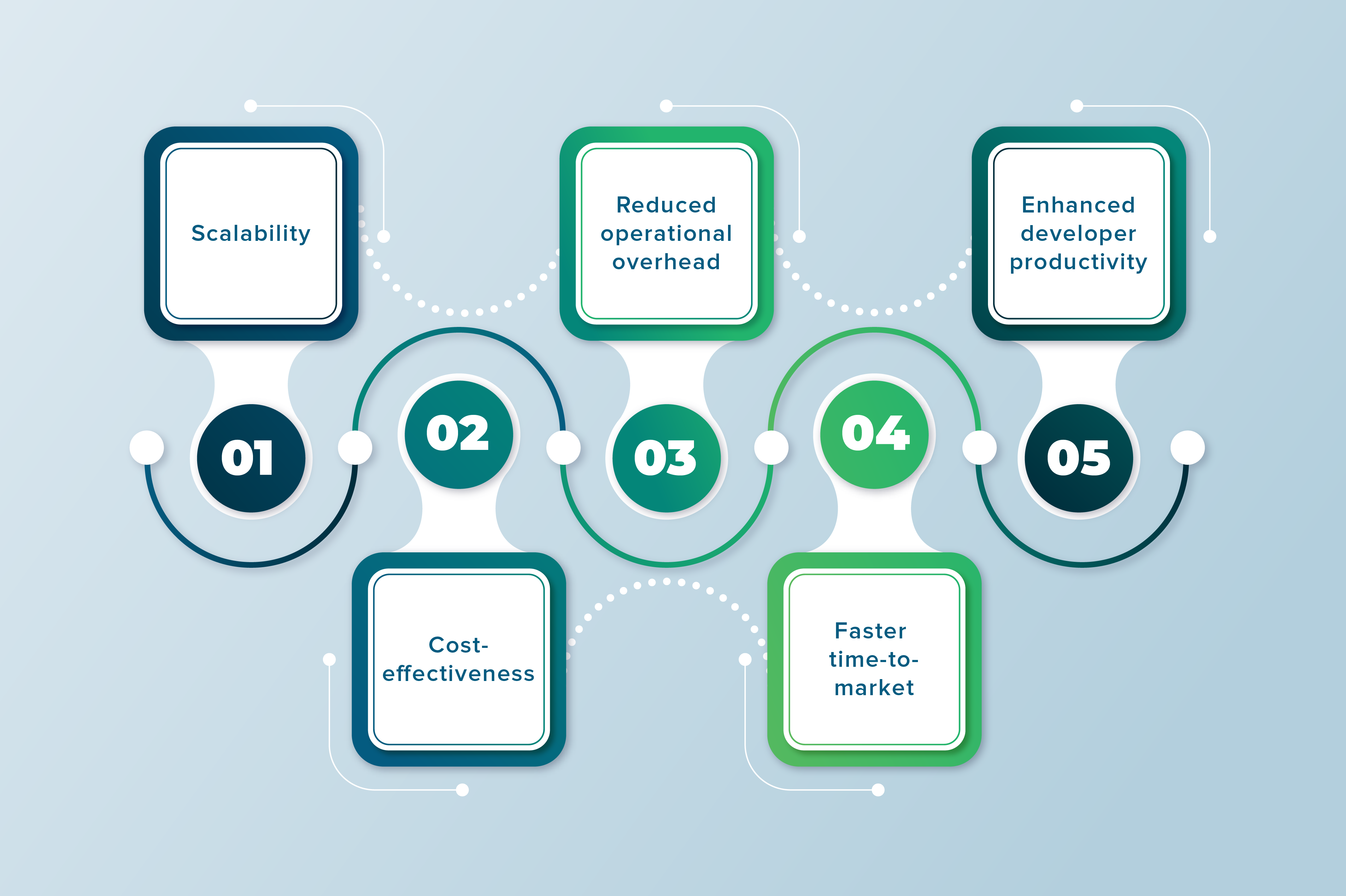Serverless Architecture Explained: Benefits & Why It Matters
Serverless architecture is a cloud computing model that enables developers to build, deploy, and scale applications without managing servers. Instead of provisioning and maintaining infrastructure, cloud providers like AWS, Azure, and Google Cloud handle server management, scaling, and maintenance automatically. In simple terms, this is serverless architecture explained — a serverless computing architecture that allows you to build applications without worrying about servers.
So, while using cloud services, the cloud provider is responsible for managing and scaling the underlying infrastructure, including the operating system. They ensure the underlying OS is properly maintained and updated for security, performance, and reliability. This relieves developers from managing the infrastructure and allows them to focus on writing code and building application-specific functionalities.
Benefits of serverless architecture:

If you implement a serverless architecture, it will generate various benefits for you such as:
The Serverless architecture enables effortless scaling to handle varying workloads, ensuring your application can accommodate sudden spikes in traffic without manual intervention — a crucial feature when building a scalable influencer marketing solution that must support high user activity and collaboration in real time.
Cost-effectiveness: The Serverless architecture enables cost savings by eliminating the cost of idle resources. When you utilize it, you only pay for the functions or services that you actually use. Being a pay-per-use model, serverless architecture leads to significant cost savings, especially for applications with fluctuating demand.
Reduced operational overhead: It abstracts away server management tasks and frees your developers from infrastructure-related concerns.
Faster time-to-market: With serverless architecture, you can perform rapid development and deployment cycles. It enables you to bring new features and updates to the market faster by streamlining workflow and automating scaling.
Enhanced developer productivity: Serverless architecture promotes a modular approach, where developers can focus on building individual functions or microservices. This modular nature enhances code reusability, collaboration, and overall productivity.
These advantages of serverless architecture not only reduce costs but also simplify operations, making it one of the fastest-growing approaches in cloud adoption.
When to Choose Serverless Architecture for Your Cloud Strategy
Understanding the benefits of serverless architecture is one thing, but knowing when to use it is just as important. Not every workload is an ideal candidate for serverless, but in the right scenarios, it can deliver significant value.
You should consider adopting serverless infrastructure in situations such as:
- Unpredictable or fluctuating traffic: When applications face sudden spikes in usage, a serverless cloud model automatically scales resources up or down without manual intervention.
- Enterprise modernization: For enterprises modernizing legacy applications and migrating to the cloud, cloud serverless architecture offers agility, reduced operational costs, and faster deployment cycles.
- Rapid product development: Startups launching MVPs or new services benefit from serverless for enterprises because it eliminates server management and allows teams to focus on innovation.
- Event-driven workloads: Scenarios like data streaming, IoT, and messaging systems are ideal for serverless since they rely on triggers and scale seamlessly with demand.
- Cost-sensitive applications: Serverless follows a pay-per-use model, making it highly cost-effective for applications with variable or seasonal workloads.
In short, the right time to choose serverless is when you want to reduce infrastructure concerns while gaining scalability, resilience, and faster time-to-market. By carefully evaluating workloads, teams can align their serverless cloud architecture strategy with business goals. This ensures enterprises adopt the right serverless solutions for scalability and innovation.
Serverless Architecture Services Across Cloud Providers (AWS, Azure, GCP)
When adopting a serverless architecture in cloud computing, one of the most critical decisions is choosing the right cloud provider. Each platform: AWS, Azure, and Google Cloud, offers a mature serverless platform with unique strengths, services, and pricing models. Understanding these differences helps businesses pick the right fit for their workloads.
AWS Serverless Services
Today, over 1.5 million customers use AWS Lambda each month, and it processes tens of trillions of requests every month. Amazon leads the way with a broad range of AWS serverless services that power modern applications at scale.
- AWS Lambda – Core of AWS serverless computing, enabling code execution without provisioning servers. Lambda is the flagship AWS serverless compute service, forming the backbone of most AWS serverless architecture services. It is widely adopted as the standard for AWS serverless architecture patterns.
- Amazon API Gateway – Simplifies API-driven architectures.
- AWS Fargate – Containerized AWS serverless infrastructure for scalable workloads.
- Rich ecosystem of AWS serverless technologies (Step Functions, DynamoDB, S3) for complete solutions.
- Proven AWS serverless architecture benefits like faster time-to-market, reduced DevOps overhead, and seamless scaling.
- Plenty of AWS serverless architecture examples, from real-time analytics pipelines to event-driven e-commerce apps.
These examples highlight how architecting serverless solutions on AWS accelerates adoption.
Microsoft Azure Serverless
Azure provides enterprise-ready serverless solutions designed for hybrid and enterprise use cases.
- Azure Functions – A direct competitor to Lambda with deep Microsoft ecosystem integration.
- Logic Apps – Automates workflows across SaaS and enterprise apps.
- Strong in serverless application architecture for companies already invested in Microsoft stack.
Google Cloud Serverless
Google Cloud emphasizes developer productivity and data-driven use cases.
- Cloud Functions – Lightweight functions for real-time events.
- Cloud Run – Container-based serverless platform that simplifies microservices deployment. Among serverless adopters, 66% of Google Cloud users now run container-based workloads (like Cloud Run), compared to 26% on AWS—up from 20% last year.
- Tight integration with BigQuery and AI/ML makes it powerful for data-heavy workloads.
Choosing the Right Serverless Provider
- Startups & innovators often prefer AWS serverless solutions due to the breadth of services.
- Enterprises lean toward Azure serverless services for Microsoft integration.
- Data-driven companies benefit from Google Cloud’s serverless application architecture with advanced analytics.
In short, whether it’s AWS serverless infrastructure, Azure Functions, or Google Cloud Run, each platform offers unique serverless architecture services that can be tailored to business needs.
How Serverless Architecture Works: A Deep Dive
By outsourcing the management of servers to a third-party provider, the serverless architecture makes server management easier and frees developers to concentrate on writing application code. Function as a Service (FaaS), a popular approach, entails writing discrete functions that execute particular tasks when triggered by events.
Firstly, developers write and test their functions in the workflow. These functions are subsequently deployed to a cloud provider together with their triggers (such as incoming email or HTTP requests). When a function is invoked, the cloud provider manages the execution process. If a server is already running, the function is executed on that server. If not, the provider spins up a new server specifically for that function's execution.
Because of this abstracted execution process, developers can concentrate on writing and deploying their application code, leaving the cloud provider to handle server management, scaling, and infrastructure issues. Thus serverless architecture enables developers to focus on building applications without managing servers—similar in principle to how AWS-powered ERP performance improvements free teams from infrastructure bottlenecks.
Key Components of Serverless Architecture & How They Function
Here are the key components of serverless platforms and how these serverless components interact to form a robust serverless application infrastructure.
-
Serverless functions:
Serverless functions are the fundamental components of serverless architecture, performing specific tasks in response to triggers or events. Cloud providers like AWS Lambda, Azure Functions, and Google Cloud Functions offer compute platforms that facilitate the execution of serverless functions. This compute engine handles resource management, automatic scaling, and availability, allowing developers to focus solely on writing function-specific code. Using serverless function platforms, developers can easily create, deploy, and scale functions, leveraging the capabilities of AWS Lambda, Azure Functions, and Google Cloud Functions.
-
Event sources:
Event sources are the triggers that invoke serverless functions. There are several different events that fall under this category, including HTTP requests, database changes, file uploads, or scheduled tasks. Event sources serve as the entry points for executing serverless functions and drive the application's overall workflow. Major cloud providers like AWS, Google Cloud, and Azure offer a range of services to support different event sources:
AWS: AWS Lambda is compatible with a variety of event sources, including Amazon S3 for file uploads, Amazon DynamoDB for database updates, Amazon API Gateway for HTTP requests, and AWS CloudWatch Events for scheduled tasks.
Google Cloud: Google Cloud Functions integrates with event sources such as Cloud Scheduler for scheduled tasks, Cloud Pub/Sub for messaging events, Firestore for database updates, and Cloud Storage for file uploads.
Azure: Azure Functions can be triggered by a variety of event sources, including Azure Logic Apps for process automation, Azure Blob Storage for file uploads, Azure Cosmos DB for database changes, and Azure Event Grid for various event types.
-
Container Orchestration
Whether it is deployment, networking, scaling, or management of containerized applications, Orchestration Services have capability to manage and streamline various aspects of containerized applications. It automates complex tasks within containerized environments like load balancing, service discovery, etc. AWS Fargate, a container orchestration service by AWS, provides a serverless compute engine that is easier to deploy and can manage container workloads on AWS without underlying compute instances, such as EC2 instances. Similarly Google Cloud Run and Azure Container Instances (ACI) offer serverless container management and deployment capabilities without the need to maintain underlying infrastructure. These services are offered by Google Cloud and Azure, respectively.
-
API gateway
For requests from external sources to interact with serverless functions, API Gateway serves as a gateway or entry point. It offers a controlled and secure API layer that manages request transformations, authorization, and authentication. AWS provides Amazon API Gateway as their serverless API management solution. Azure offers Azure API Management, and Google Cloud provides Google Cloud Endpoints, serving as the equivalent services in their respective cloud platforms. Developers can easily integrate their serverless operations with other systems or client apps by exposing them as RESTful APIs or event-driven endpoints using API Gateway.
-
Storage and databases
Scalable and durable storage for files and objects is offered by object storage services like Amazon S3 in AWS. Similarly, Azure provides Azure Blob Storage, and Google Cloud offers Google Cloud Storage as their equivalent service for storing files and objects in a scalable and durable manner. For managed NoSQL databases, AWS provides Amazon DynamoDB, while Azure offers Azure Cosmos DB, and Google Cloud provides Google Cloud Firestore and Google Cloud Bigtable, ensuring high performance and scalability for storing and retrieving data in a serverless environment. For industries like telecom, cloud providers even offer serverless storage for telecom, ensuring scalable, real-time data management without traditional infra costs.
-
Authentication and authorization
Strong authentication and authorisation techniques are needed for serverless architectures to secure access to resources and functions. Identity providers and security services like AWS Cognito, Azure Active Directory, or Google Cloud Identity and Access Management (IAM) provide the necessary authentication and authorization capabilities to control access to serverless functions and protect sensitive data.
-
Messaging serverless service
A cloud-based service, Messaging Serverless in a serverless architecture handles sending, receiving and process of message. AWS Simple Queue Service (SQS) and Simple Notification Service (SNS) are the key components in event-driven architectures enabling messages to be sent, stored, and retrieved between independent components. Similarly, Azure Service Bus, a Serverless messaging service, also enables decoupling and scale applications through message-based communication patterns whereas Cloud Pub/Sub, serverless messaging service of GCP, enables event-driven and secure communication between independent applications and components.
The Future of Serverless Security: Challenges & Innovations
Looking ahead, the future of serverless computing is extremely promising. The global serverless architecture market valued at around USD 14.2 billion in 2024 is expected to climb to USD 124.5 billion by 2034, growing at a robust 24% CAGR. This signals strong enterprise adoption and continuous innovation across providers.
As serverless architecture continues to develop, the focus on security becomes increasingly crucial. Although serverless systems come with built-in security features like automatic scaling and resource separation, developers and cloud providers must work together to protect data and applications.
Future developments are necessary for serverless security, including:
Access control By evolving fine-grained access control techniques, more precise permissions for serverless functions will be possible. This comprises components' secure communication as well as authentication and authorization.
Vulnerability management Continuous vulnerability scanning and monitoring will be integrated into serverless platforms. Before they can be exploited, this proactive strategy assists in identifying and mitigating potential security issues.
Encryption and data protection Enhanced encryption techniques will be created to protect data while it is in transit and at rest. To protect data privacy and integrity, serverless platforms will enable a seamless connection with encryption services and key management systems.
Runtime protection Advanced runtime protection methods will be used to detect and prevent runtime assaults on serverless operations, including code injection and malicious behavior.
Compliance and auditing To comply with legal obligations, serverless platforms will include strong compliance and auditing tools. Providing accountability and transparency entails logging, monitoring, and reporting capabilities.
Security testing and DevSecOps Security testing frameworks and tools specific to serverless architectures will emerge, facilitating the integration of security into the DevOps pipeline. In order to ensure that security is prioritized throughout the development lifecycle, DevSecOps practices will spread more widely.
Use Cases of Serverless Architecture in Real-World Applications
Let's explore a couple of real-world use cases of serverless architecture where it proves its mettle in delivering scalable, efficient, and cost-effective solutions:
Use Case 1: Coca-Cola's vending machine payment service
Coca-Cola implemented a serverless architecture for their vending machines' payment service. By utilizing serverless functions, they achieved seamless and secure payment transactions, eliminating the need for manual server management. This resulted in a streamlined payment process and enhanced customer experience.
Use Case 2: Live streaming services
Serverless architecture excels in handling data streams, making it an ideal choice for live streaming services. With its efficient scaling capabilities, serverless can effortlessly handle sudden spikes in viewer traffic. By leveraging serverless functions, live streaming platforms can deliver real-time content to a large audience while optimizing costs and ensuring a smooth viewing experience.
Get Started with TenUp: Your Trusted Serverless Solutions Partner
Serverless architecture offers a new approach to software development and tackles new technology challenges. Serverless is the next evolutionary stage that decreases complexity and increases protection across all edges. Whether it’s AWS, Azure, or GCP, our expertise in serverless development ensures clients unlock the full serverless architecture advantages. We, at TenUp, offer Serverless architecture solutions with exceptional security features by focusing on the logic of customer interaction and infrastructure operations.
Additionally, our Serverless Application Development services help businesses build scalable, cost-effective applications that focus on agility and faster time-to-market, ensuring a seamless and efficient solution for your needs.
Frequently asked questions
What’s the difference between serverless and container-based architecture?
Serverless abstracts all infrastructure, runs code only on demand, and charges per execution, ideal for event-driven apps. Containers give developers full runtime control, need orchestration, and suit long-running or portable workloads. Many teams use both together.
Can serverless computing handle AI and machine learning workloads?
Yes. Serverless is well-suited for real-time inference, event-driven predictions, and lightweight ML tasks since it scales automatically and charges only per use. Large model training still needs GPUs or containers, but serverless integrates seamlessly with AI services for faster, cost-effective deployment.
How does serverless architecture impact application latency?
Serverless can improve latency with auto-scaling and edge deployments, but cold starts add delays after inactivity. Using provisioned concurrency and leaner code reduces these delays, keeping response times consistent.
Is serverless more cost-effective than Kubernetes for enterprise apps?
It depends on the workload. Serverless is cheaper for unpredictable, bursty traffic with pay-per-use pricing. Kubernetes is often more cost-efficient for steady, long-running workloads. Many enterprises use a hybrid approach to balance costs.
How does serverless architecture fit into multi-cloud strategies?
Serverless enables multi-cloud flexibility by abstracting infrastructure, but vendor-specific functions (AWS Lambda, Azure Functions, GCP) can create lock-in. Frameworks like Knative and OpenFaaS offer portability, helping enterprises balance agility with multi-cloud freedom.
Can legacy applications be migrated to serverless?
Yes, but not directly. Legacy apps often need refactoring into event-driven components. Many enterprises modernize gradually—migrating APIs, batch jobs, or background tasks to serverless while keeping core workloads in containers or VMs.
How do you monitor and debug serverless applications?
Serverless apps are monitored with logs, metrics, and distributed tracing instead of traditional servers. Tools like AWS X-Ray, Azure Application Insights, and GCP Cloud Trace capture performance, errors, and request flows, while log aggregation and alerts ensure quick debugging.
What’s the future of serverless beyond 2025?
Beyond 2025, serverless will evolve into AI-powered, full-stack platforms with autonomous scaling and serverless-first data pipelines. With the market projected to reach $58.95 billion by 2031 (according to a study by Persistence Market Research), it’s set to become a mainstream cloud foundation.

